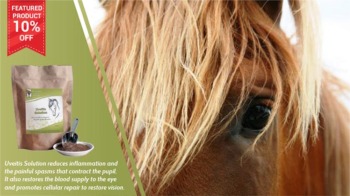To Stop an Acute Laminitic Episode and prevent further hoof damage:
MMP Stop: When an acute laminitic episode starts, the flood gate release of the enzyme MMP is responsible for the greater part of hoof damage. MMP Stop WILL STOP an acute laminitic event if given very near the initial onset. It will also assist in the recovery from hoof damage and re-regulate MMP action even when given past the initial 48-72 hours.
Explanation: In the normal hoof, very sensitive laminae must relax just a bit to allow your horse’s hoof wall to grow, but not too much, and then tighten up again. This is very carefully regulated by the enzyme matrix metalloproteinase (MMP.) During laminitis, a floodgate release of MMP into the affected hoof causes laminae to relax to the point they stretch and tear under the weight of your horse. The torn laminae allow the coffin bone to separate from the hoof wall. At this point, your horse is in a great deal of pain. In extreme cases, the coffin bone can sink so far that it penetrates the sole.
We recommend MMP Stop to end the laminitic episode quickly and minimize damage to your horse’s hoof (hooves). We advise you to keep this product on hand if your horse has a history of laminitis.
If you do not have MMP Stop on hand: Within the first 48 hours after laminitis is triggered, soak the affected hoof (hooves) for 30 minutes every two hours, or as often as practical, in a combination of 1/2 ice and 1/2 water. If ice is not available, use the coldest water possible.
Explanation: When an acute episode of laminitis begins, blood vessels to the hoof dilate allowing an influx of toxins that increases the enzyme MMP activity. Cold therapy has been shown to contract the blood vessels and reduce damage to the hoof.
Complete a Support Services Questionnaire. Dr. Thomas and the Support Staff at For Love of the Horse will provide you with personalized recommendations for your horse, and assist you with any questions you might have during its recovery.
Care and Management during and after a Laminitic episode:
The Foundation for Recovery, our EMS/Cushing’s/IR Solution: It is important to understand that laminitic horses are all living with some degree of metabolic dysfunction. The hoof is really the “canary in the coal mine” signaling that something is amiss inside your horse. Our EMS/Cushing’s/IR Solution is the foundation formula for recovery from Insulin Resistance (IR), the underlying metabolic dysfunction. Without it, the progressive nature of IR will cause your horse to suffer from relentless laminitic attacks which will increase in frequency and severity over time.
Remove possible “triggers” from diet: The most common trigger of a laminitic episode is too much sugar/fructans in the diet. Sugars can take many different forms. Grass and grain both contain a variety of sugars. Right now it is important to not let your horse get any worse. Get your horse off pasture and into a dirt lot. If that is not possible, consider a grazing muzzle. Take all grain out of the diet, immediately. Purchase low carbohydrate hay (tested for less that 10% water soluble carbohydrates and starch.) If that is not immediately available, soak your horse’s hay for 30 minutes in hot water, or 60 minutes in cold water before feeding. Soaking will leach sugars out of the hay and make it safe for your horse to eat.
Discontinue feeding alfalfa/high protein feeds: Alfalfa and high protein feeds are triggers for laminitic horses. When a horse eats protein, the stomach responds by secreting a compound that signals the pancreatic beta-cells to secrete more insulin into the blood. This is a normal response and fine in a healthy horse. However, a laminitic horse is insulin resistant meaning there is already elevated insulin in the circulating blood and these insulin bursts exacerbate the IR horse’s metabolic problems while increasing the risk of an acute laminitic episode.
Appropriate movement is essential to recovery: Movement is necessary to provide needed stimulation and circulation to the hoof. Only your horse can determine when it is ready to move, what type of movement is comfortable, and for how long it can safely move. Forcing your horse to move too soon, can increase damage in the hoof. Conversely, stalling a horse will reduce circulation necessary for healing producing more damage to the hoof. It is important to emphasize that movement is ESSENTIAL to hoof recovery but not forced movement.
A balanced barefoot trim: We highly recommend you have an experienced barefoot trimmer trim your horse’s hooves. Simply removing shoes or implementing a “pasture trim” is not enough to support the recovery of a foundered horse.
Explanation - A balanced barefoot trim will help your horse in these ways:
- Keep the coffin bone parallel to the ground. This eases pain and prevents further tearing of the sensitive laminae.
- Provide a good breakover with shortened toes and a mustang roll so the horse has a heel first landing.
- Low heels to help avoid pitching the foot forward and adding additional stress to the already stretched and torn laminae.
- Keeping your horse barefoot will allow for frequent trimming needed to keep the heels low. Low heels help avoid pitching the foot forward which would only add stress to the already stretched laminae.
Recovery of the Damaged Hoof
Abscessing: The abscessing that follows an acute laminitic episode causes lingering pain which can last for days, weeks or more. These symptoms are often mistaken for an ongoing laminitic episode or subsequent laminitic episodes when, in fact, they indicate the bacterial infection of an abscess.Hoof Ailments Solution will speed your horse’s hoof recovery by promoting the discharge or reabsorption of the pus and regenerate new tissue. Use along with
Total Immune Health to recover from ongoing infection.
Explanation: Laminitis is a consequence of Insulin Resistance. This metabolic dysfunction weakens the immune response making it difficult for the IR horse to recover from the tissue damage of an acute laminitic episode. In a healthy horse inflammation is rapidly contained as white blood cells go to work cleaning up injured tissue and fighting off invading bacteria. In the IR horse, the immune function is impaired as IR horses are deficient in the specific types of white blood cells needed to clean up the damage and fight off infection. So an abscess forms and as the fluid builds within the confines of the hoof capsule so does the pain your horse endures.









